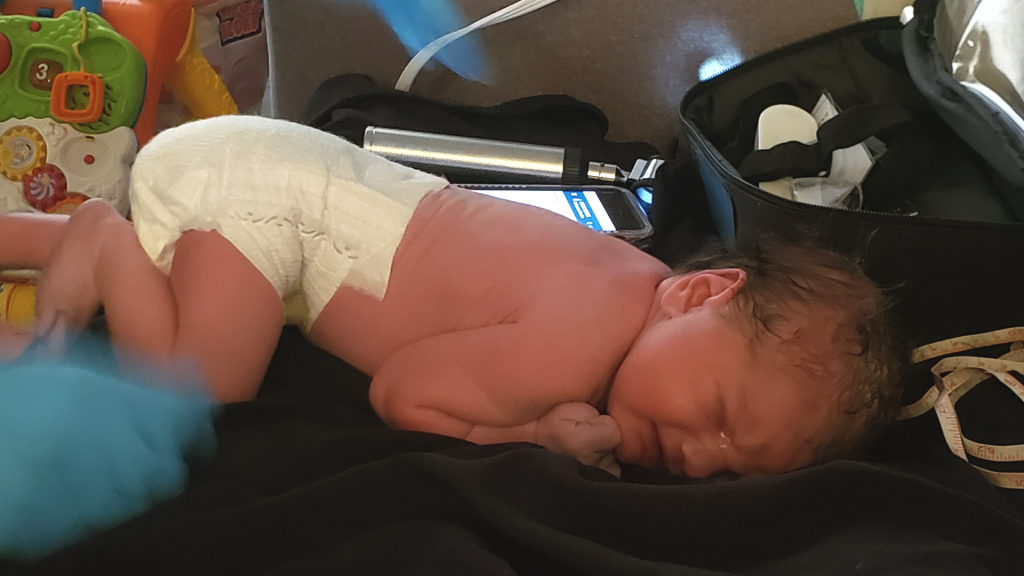There are a few common misconceptions about homebirth that are often enough to dissuade moms from pursuing this method. Let’s discuss a few and see what you think afterwards.

The most significant category of misconceptions about homebirth are about safety. This ranges from concern that medical interventions in an emergency will not be available, to how much training a midwife has, to how clean the birthing environment is. So let’s break it down a little bit.
Safety Misconceptions about Homebirth
How sanitary is a homebirth?
Your homebirth will be as sanitary as you make it. Nothing about birthing in a hospital changes the bodily fluids you’ll excrete or cleanliness of your baby’s pathway into the world. A hospital setting will have been cleaned with strong chemical cleaners by a professional cleaning crew. And that can be a good thing.
However, it is worth taking into account that the chemicals themselves can be detrimental to a newborn as well as to a mama whose body should be focused on recuperating rather than dealing with potentially toxic chemicals. (If you’re wondering how hospital approved cleaning chemicals can possibly be toxic, pull up a chair and we’ll begin a much, much deeper discussion!)
If your home is cleaned to its normal state of cleanliness, or a bit beyond that for your sanity, you and baby will be just fine. Your body is accustomed to the germs and bacteria that are normally and naturally present in your home, so fighting off any kind of bacteria at home is a lot less foreign than fighting off the countless germs and bacteria that are present in a hospital, even one that is well cleaned. Hospitals are, afterall, a place where sick people go, and we should expect them to have more germs than our homes.
If the space you have set up to birth your baby is appropriately clean, and your baby gets prompt skin-to-skin contact and begins to nurse at all, you are setting your child’s immune system up for success in tackling any kinds of bacteria they will begin to encounter. In fact, your body and your immune system will step up to help that baby fight that bacteria through your breast milk! How incredible is that?
Cleaning up after your homebirth is important in terms of cleanliness and safety as well. Normally your midwife, doula, spouse, or other support person can help with these things as you go, from removing chuck pads with poop on them, to cleaning a birth tub or disposing of the tub liner, to making sure no blood is left on any surface as a biohazard. These measures are the same ones that would be taken in the hospital – you just need someone willing and able to do them in your home as well. It is actually a lot less involved and complex than you would imagine.
What about emergencies?
This question is a big one that carries a lot of potential scenarios (just as an emergency in the hospital does) and also various outcomes. It is completely fair to think ahead to how you would manage different scenarios in an emergency, and it is an important topic to discuss with your midwife if you are having such concerns.
High risk pregnancies
To begin with, midwives are highly trained professionals, and their goal is primarily that you give birth to a healthy baby in a safe manner and that both mama and baby are doing well at the end. They aren’t hell-bent on you having a homebirth if your condition isn’t optimal or if there are signs of an impending emergency.
Midwives specifically keep an eye out for signs of distress in mother and baby. Their job in monitoring your pregnancy and labor is to spot any and all red flags that would give your labor a negative outcome.
This is why during your pregnancy you are constantly questioned and evaluated based on your symptoms, and usually if there are red flags for your health or baby’s, those things are spotted and addressed long before you go into labor. When a pregnancy becomes “high risk” and you and your midwife have worked together to remove those risks (through lifestyle, diet, and medicinal approaches) but your condition hasn’t resolved, your midwife will ask you to transfer care to a hospital for your safety and baby’s safety.
So it is important to remember that if you have been up front with your midwife throughout your pregnancy and your midwife is comfortable with you pursuing a homebirth, that is a seal of approval from your midwife that in her estimation, your homebirth will be a successful one.
Emergencies during labor
Once you are in active labor and you’ve called your midwife, all sorts of monitoring will begin, much as it does in the hospital, but usually in a less intrusive manner.
Midwives can monitor your progress in many ways, from cervical checks to doppler readings of baby’ heartbeat to keeping an eye on your pulse and outward condition.
When needed, midwives can perform small interventions as well, like manually turning baby, breaking your water, giving you a saline IV drip, providing oxygen in a tank, and sometimes even using a small wand and computer program to check on baby via ultrasound. There are countless things that midwives are able to help you with that you wouldn’t ever guess simply because most homebirths do not necessitate these types of interventions.
Once baby is born, midwives can do even more for you and baby. They can suture any tearing you may have (though even tearing is less common in homebirths than it is in the hospital). They can do CPR on baby or mother if needed. They can resuscitate baby if need be. They can immediately see and unwrap a twisted umbilical cord that may prevent baby’s first cries.
These are many of the same interventions that such “small emergencies” would require in a hospital. If more need to be done than this, they can promptly make the necessarily contact for an ambulance and transfer directly into the most relevant local hospital for both mother and child. Many midwives can even accompany you and continue some level of care for you or your child in a hospital if that is necessary or appropriate. In short, midwives are experts at knowing what you need and either providing it themselves, or letting you know it is time to seek more advanced medical care.
Disclaimer: in circumstances of emergency transfer during labor or after a birth, your proximity to your nearest hospital is of importance, and can determine the outcome of a transfer. However, this is something that you would have already discussed with your midwife ahead of time and she would definitely have weighed as part of her decision to offer you her homebirth services. The same midwife may consider it a different risk level to conduct a homebirth out in the boonies an hour from a hospital versus the same situation but next door to a hospital.
Just remember – your midwife wants you and your baby to have a healthy pregnancy and labor above all else, so they’re going to take in all the information and make the decisions that will give you that positive outcome.

Misconceptions about Homebirth and Pain
The second most common category of misconceptions about homebirth is in regards to pain and why women would choose a painful home delivery rather than a medicated, less painful birthing experience. Let’s talk about it.
Unmedicated pain management
One of the most common misconceptions about homebirth is that because you cannot get an epidural at home, that there is no pain management available and you’re going to have so much paid you’d wish you’d never been born.
(Is that a slight exaggeration? That’s what I hear from a lot of moms!)
The good news is that there are very helpful forms of pain relief to be had during a homebirth, and most of them enable you to remain intuitively connected to your labor in a way that is difficult with an epidural.
Essentially an epidural is a numbing agent that removes most sensations altogether rather than just sensations of pain. This makes it difficult to discern when you are having a contraction, which poses difficulty in knowing when to push. Pushing without the direct aid of a contraction is one of the primary causes of tearing during labor, as well as a prolonging of the labor itself.
So what can you do for pain relief during an unmedicated homebirth and why are they good options?
Options for managing pain at home
Most options for at home pain management depend a lot on execution, meaning they will help you in proportion to how well you use them.
That sounds like work. Maybe that’s why we call it “labor.”
Here are some of the most common methodologies and practices used in childbirth that are used to help labor progress smoothly and without giving into fear and pain. There are others, but these are the ones we hear about most often.
- The Bradley Method: emphasizes partner-led coaching and relaxation of the whole body as the primary form of releasing pain
- Lamaze Technique: uses relaxation, movement, massage, and partner-led coaching to boost a mother’s confidence and equip her with various coping mechanisms for pain
- Water Birth: utilizes warm or hot water throughout labor to soften the cervix, provide buoyancy, and soothe pain (usually in tandem with other relaxation methods)
- Hypno Birthing: uses self hypnosis and mental exercises to reduce fear, anxiety, and moderate pain during labor
- Doula coaching: coaching through a professional doula to use mental exercises, breathing exercises, and physical compressions and positioning to reduce pain and anxiety
Many of the principles across these methods are the same and there is a lot of overlap. If you notice from the descriptions, they are all focused on figuring out what your body is doing and using multiple methods to guide your body through the pain and the phases of labor rather than simply numbing all pain away. This allows you to maintain your body’s natural intuition about what you need most to keep labor progressing and get that baby into your arms.
Choosing a method or parts of several methods that resonate with your physical needs and your mental space is important. If you try to use a method that you are not comfortable with or that is more of a struggle than an assistant, it will not be as successful for you as trying out another method. Find what works for you. Some women even claim to be able to have pain-free unmedicated births using some of these methods, so it is definitely something worth looking into!

